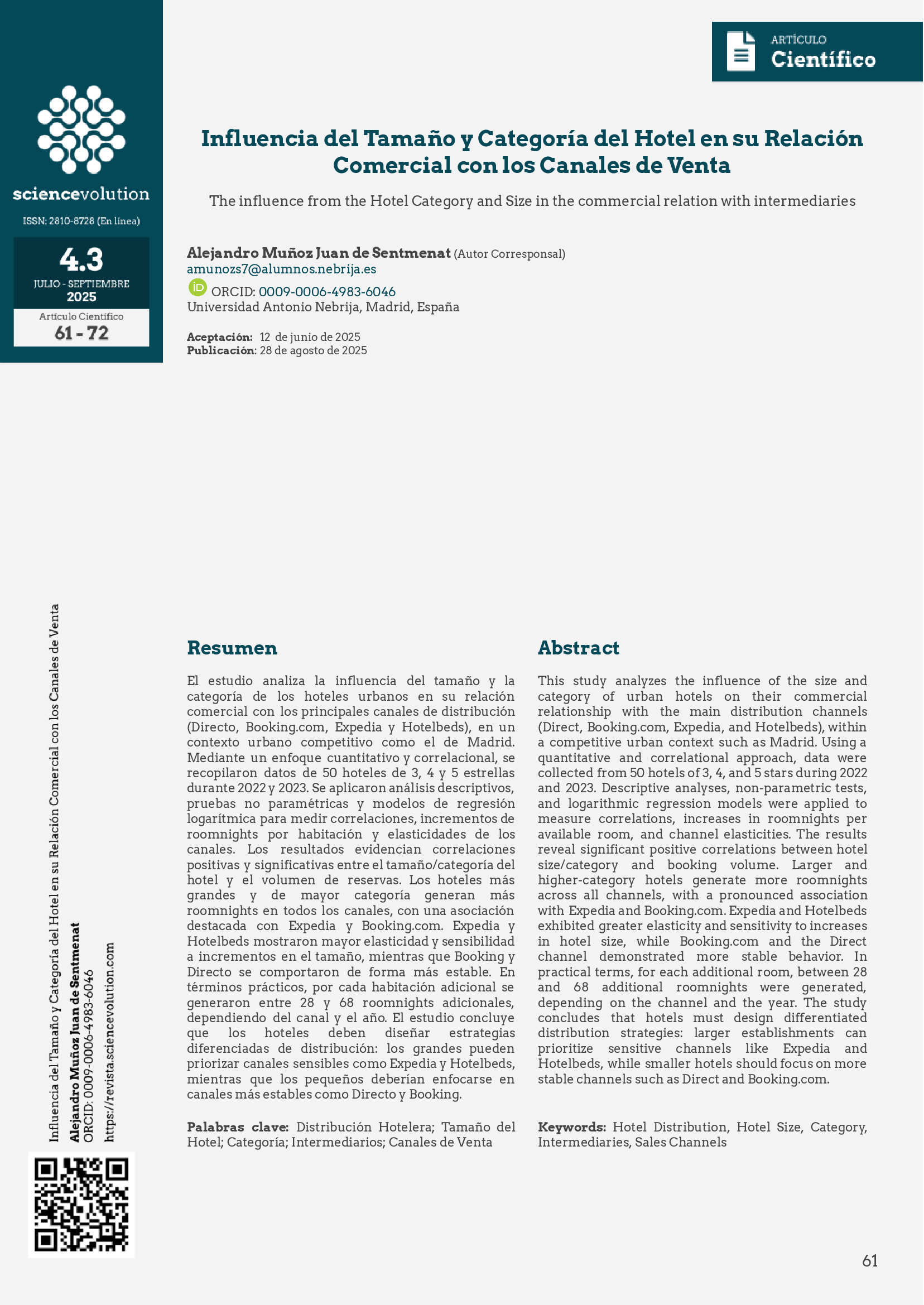Abstract
This study analyzes the influence of the size and category of urban hotels on their commercial relationship with the main distribution channels (Direct, Booking.com, Expedia, and Hotelbeds), within a competitive urban context such as Madrid. Using a quantitative and correlational approach, data were collected from 50 hotels of 3, 4, and 5 stars during 2022 and 2023. Descriptive analyses, non-parametric tests, and logarithmic regression models were applied to measure correlations, increases in roomnights per available room, and channel elasticities. The results reveal significant positive correlations between hotel size/category and booking volume. Larger and higher-category hotels generate more roomnights across all channels, with a pronounced association with Expedia and Booking.com. Expedia and Hotelbeds exhibited greater elasticity and sensitivity to increases in hotel size, while Booking.com and the Direct channel demonstrated more stable behavior. In practical terms, for each additional room, between 28 and 68 additional roomnights were generated, depending on the channel and the year. The study concludes that hotels must design differentiated distribution strategies: larger establishments can prioritize sensitive channels like Expedia and Hotelbeds, while smaller hotels should focus on more stable channels such as Direct and Booking.com.
References
Abdullah, S., Van Cauwenberge, P., Vander Bauwhede, H., & O’Connor, P. (2022). The indirect distribution dilemma: Assessing the financial impact of participation in Booking.com for hotels. Tourism Review, 77(4), 1024–1042. https://doi.org/10.1108/TR-03-2020-0101
Ali, B. J., Gardi, B., Othman, B. J., Ahmed, S. A., Ismael, N. B., Hamza, P. A., Aziz, H. M., Sabir, B. Y., Sorguli, S., & Anwar, G. (2021). Hotel service quality: The impact of service quality on customer satisfaction in hospitality. International Journal of Engineering, Business and Management, 5(3), 14–28. https://doi.org/10.22161/ijebm.5.3.2
Instituto Nacional de Estadística. (2025). Encuesta de ocupación hotelera: Tablas estadísticas [Archivo Excel]. Subdirección General de Estadística, Ayuntamiento de Madrid. https://www.madrid.es/UnidadesDescentralizadas/UDCEstadistica/Nuevaweb/Turismo%20y%20eventos/Turismo/Encuesta%20Ocupaci%C3%B3n%20Hotelera/Tablas/P1110225.xlsx
Bigné, E., Nicolau, J. L., & William, E. (2021). Advance booking across channels: The effects on dynamic pricing. Tourism Management, 86, 104341. https://doi.org/10.1016/j.tourman.2021.104341
Carneiro, T., Picoto, W. N., & Pinto, I. (2023). Big data analytics and firm performance in the hotel sector. Tourism and Hospitality, 4(2), 244–256. https://doi.org/10.3390/tourhosp4020015
Chhikara, S., Singh, K., & Shrivastava, D. (2024). The role of technology in hospitality and tourism sector. International Journal of Recent Advances in Information Technology & Management, 8(1), Eureka Journals. https://www.researchgate.net/publication/380532402_The_Role_of_Technology_in_Hospitality_and_Tourism_Sector
D-Edge. (2024). Hotel distribution report 2024: Have direct bookings reached a peak? https://www.d-edge.com/wp-content/uploads/2024/04/Hotel-Distribution-Report-2024-EN.pdf
D-Edge (2023). 2023 hotel online distribution trends: Europe & Asia – Drawing insights from 2019–2023 data to guide 2023 hospitality marketing & revenue strategies. Hospitality Net. https://www.hospitalitynet.org/news/4116110.html
Phocuswright. (2021). Europe Travel Market Report 2020-2024 [Reporte]. https://www.phocuswright.com/Travel-Research/Market-Overview-Sizing/Europe-Travel-Market-Report-2020-to-2024
García-López, A. M., Galindo-Pérez-de-Azpillaga, L., & Foronda-Robles, C. (2025). The flow of digital transition: The challenges of technological solutions for hotels. Social Indicators Research, 178, 1323–1346. https://doi.org/10.1007/s11205-024-03487-5
HES-SO Valais-Wallis, Tourism Institute. (2022). 2022 hotel distribution study results: Revival of direct bookings. HES-SO Valais-Wallis. https://www.hevs.ch/en/news/2022-hotel-distribution-study-results-revival-of-direct-bookings-203255
Nikopoulou, M., Kourouthanassis, P., Chasapi, G., Pateli, A., & Mylonas, N. (2023). Determinants of digital transformation in the hospitality industry: Technological, organizational, and environmental drivers. Sustainability, 15(3), 2736. https://doi.org/10.3390/su15032736
O’Connor, P., Assaker, G., & Haddad, R. E. (2025). Online travel agency participation: An empirical investigation of its financial contribution to U.S. hotel profitability. Cornell Hospitality Quarterly. Advance online publication. https://doi.org/10.1177/19389655251318185
Pastor Ruiz, R., & Rivera García, J. (2022). El rol de la agencia de viajes ante la nueva situación post-COVID-19: Decálogo de propuestas para su recuperación. PASOS: Revista de Turismo y Patrimonio Cultural, 20(1), 55–68. https://doi.org/10.25145/j.pasos.2022.20.004
Quaglione, D., Crociata, A., Agovino, M., & Iaia, L. (2020). Cultural capital and online purchase of tourism services. Annals of Tourism Research, 79, 102797. https://doi.org/10.1016/j.annals.2019.102797
Raad, J., Sharma, A., & Nicolau, J. L. (2023). Performance effects of innovation in two-sided markets: The paradigmatic case of OTAs. Tourism Management, 94, 104637. https://doi.org/10.1016/j.tourman.2022.104637
Sánchez-Lozano, G., Nobre Pereira, L., & Chávez-Miranda, E. (2021). Big data hedonic pricing: Econometric insights into room rates’ determinants by hotel category. Tourism Management, 85, 104308. https://doi.org/10.1016/j.tourman.2021.104308
Steinhauser, C., & Bohne, H. (2018). Multi channel strategy: An empirical and theoretical analysis of online distribution channels in the hospitality industry. Journal of Tourism Research, 19, 83–93. https://www.jotr.eu/index.php/volume19/219-multi-channel-strategy-an-empirical-and-theoretical-analysis-of-online-distribution-channels-in-the-hospitality-industry

This work is licensed under a Creative Commons Attribution-NonCommercial-NoDerivatives 4.0 International License.

